Cultural Psychology
M7.1 - CULTURE & COGNITION

⭐BUT Muller-Lyer illusion is NOT UNIVERSAL⭐
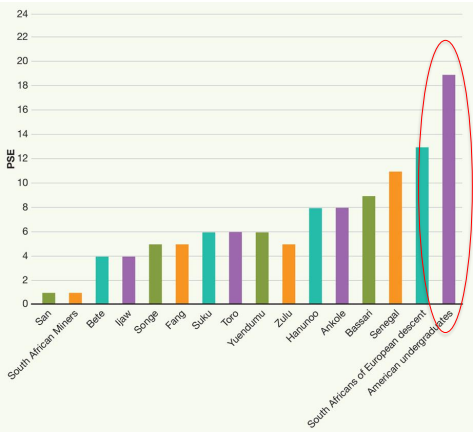
American undergraduates (red circled) are the outliers here → the line needs to be much longer for them to realize they that they are the same length
However, this illusion does not exist in other cultures such as South African miners!
Culture AS Cognition
psychologists view culture as cognition
L1:
“human culture as unique meaning and information system"
norms, values, opinions, beliefs, and worldviews
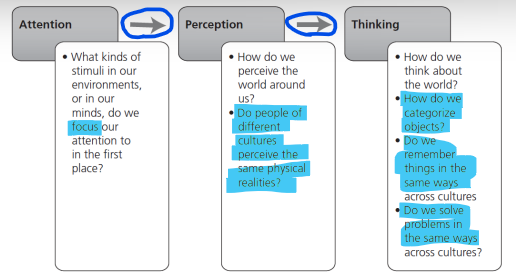
Early Research on Culture and Perception: Illusions
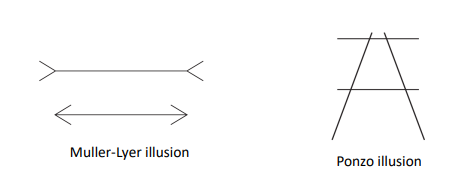
Ponzo illusion: top line looks longer because we assume it is far away
Possible Explanations for Optical Illusions
Muller-Lyer → carpentered world: suggests that people in urbanized, industrialized societies are used to seeing things that are rectangular in shape
→ unconsciously expect objects to have squared corners
Ponzo → front-horizontal foreshortening: interpretation of vertical lines as horizontal lines extending into a distance
Contemporary Cross-Cultural Research: Analytic vs Holistic Cognition
analytic cognition:
Western
analytic / logical
focused on cause-effect linkages specific key variables or objects
deterministic and precise
holistic cognition:
East Asian
focused on systems, interrelationships, mutual interdependence
multiplicity of explanations
Analytic & Holistic Cognition: Attention
analytic:
context-independent and analytic perceptual processes that focuses on salient objects
holistic:
context-dependent: attending to the relationship between the object and the context in which it is located
Example: Americans & Japanese differed in paying attention to background objects
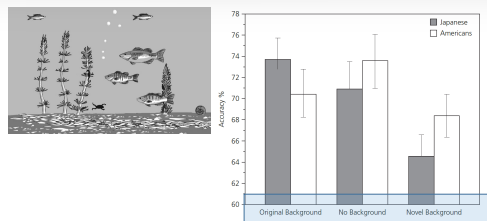
part 1: what do you recall?
the Americans and the Japanese were equally good at recalling the central objects
but the Japanese participants were better at recalling the background objects
part 2: were these objects present (same / no / different background) ?
same background: the Japanese participants were more accurate recalling
no background: equally good at recalling
different backgrounds: the Japanese participants were a lot less accurate in recalling
📘Analytic & Holistic Cognition: Categorization📘
Western (analytic): sort by function
African (holistic): sort by color
American (analytic): grouped things according to shared features
grouped man and women together because they are both adults
Chinese (holistic): grouped this according to shared contextual or functional relationship
grouped the women and the children together because of their relationship
bilingual Chinese categorized objects in more relational way, regardless of whether they were tested in English or Chinese
Analytic & Holistic Cognition: Attributions
fundamental attribution error: a tendency to explain the behaviors of others using internal attributions but to explain one’s own behavior using external attributions.
East-West differences in attributional styles:
Social explanations among Americans and Hindu Indians
American respondents: more internal attributions (Analytic) → distributional attribution
Hindu Indians: more external attributions (Holistic) → situational attribution
📘Analytic & Holistic Cognition: Reasoning: Dialectical Thinking📘
positive logical determinism (analytic): tendency to see contradictions as mutually exclusive, categories, either-or → exclusive faults with one side
dialectical thinking (holistic): tendency to accept what seem to be contradictions in thought or beliefs → tries to find a way in which both sides of the contradiction are correct, tolerates the contradiction, and finds mutual middle grounds (greater expectation of change)
dialectical thinking can be applied to different domains such as self, emotional experience, psychological well-being, attitudes and evaluations, social categorization and perception, and judgement and decision making:
positive and negative feelings are negatively correlated in Western cultures
BUT, in East Asia they are either not or positively correlated
→ these expansions of the dialectical thinking lead to naive dialectivism: a constellation of lay beliefs about the nature of the world (rather than a cognitive style like dialectical thinking). It is characterized by the belief that the truth is always somewhere in the middle
Contrarily, Western lay theories are dominated by the idea that something cannot be both true and false at the same time
📘Analytic & Holistic Cognition: Memory📘
self vs other focus: whether memories contain information about oneself vs others, and is considered to be associated with goals and motivations
cultures that prioritize individuality and self agency
cultures that prioritize interdependent goals
valence: degree to which memories are positively or negatively nuanced → related to self-esteem and self-enhancement
Western remember more events that boost their self-views
East Asian remember events that are related to self-evaluation and improvement
subjectivity: experiential components of memories → emotions, thoughts and desires
European American cultures express their inner thought and feeling more than East Asian cultures
specificity: Western cultures would show greater specificity in memories compared to Asian cultures because idiosyncratic details would foster emphasis on individuality and autonomy
function: purpose that memories serve
Western cultures use memories to create meanings about their personal identities
East Asian cultures use memories to create meanings about roles and relationships
Overview: Analytic vs Holistic Cognitive Patterns
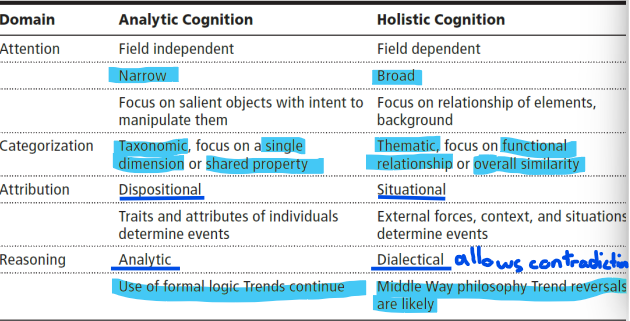
Why These Analytic vs Holistic Cognitive Patterns? The Social Orientation Hypothesis
because of independent and interdependent self:
independent self:
bounded, separate → so it makes sense to focus on one single object
the important elements of the self are internal → which explains why they make more internal attributions for other people
interdependent self:
overlaps with others → explains why attention is more on the relationships between objects
important elements of the self are the ones that overlap with others → explains why they make more external attributions because they understand themselves and others better with context
How Convincing is the Social Orientation Hypothesis?
cultural differences in cognitive tasks may be situational to experiments
performance on cognitive tasks depend on situational cues
contrast was primed → everyone analytical
assimilation and connection were primed → everyone holistic
attributional biases may be more universal than thought
when they had both dispositional and situational information both easterners and westerners made the same attribution
no cultural differences for locus of control
analytical →
internal locus of controlholistic →
external locus of control
some effects of memory are likely universal
effects of education
poorer eastern countries (bigger classes) → root learning: more memorizing and less interaction
richer western countries (smaller classes) → less memorizing and more interaction
⭐differences in cognition are NOT coming from ancient societal orientations⭐
M7.1 - SUMMARY
⭐NO dichotomous analytic vs holistic ⭐
M7.2 - CULTURE & INTELLIGENCE
Lynn & Verhanen controversies:
claimed that average IQ in Africa is 70 (based on 50 country study)
“men more intelligent than women”
Is This racist?
Lynn surely is
"What is called for here is not genocide, the killing off of the population of incompetent cultures. But we do need to think realistically in terms of the 'phasing out' of such peoples."
member of ku klux klan (KKK)
WTF!!!!
Is This Good Science?
“In light of all the available IQ data of over 37,000 African test-takers, only the use of unsystematic methods to exclude the vast majority of data could result in a mean IQ close to 70. On the basis of sound methods, the average IQ remains close to 80. Although this mean IQ is clearly lower than 100, we view it as unsurprising in light of the potential of the Flynn Effect in Africa (Wicherts, Borsboom, & Dolan, 2010) and common psycho-metric problems associated with the use of western IQ tests among Africans.
“The degree to which measurement bias has affected IQ levels in African samples is unclear”
Lynn:
cherry picked results to make it fit his hypothesis
used culture specific tests → measurement bias !!!!
! in 2020 Lynn’s article was used as a reference in an article → it obviously got retracted !
Are racial & cultural differences in IQ due to measurement? Bias !!!!
Some IQ test questions used in US:

→ there is not many trains in the US
“how does a violin resemble a piano?”
→ this doesn’t represent every social class
> CULTURE FAIR TEST?
Catell Culture Fair Intelligence Test
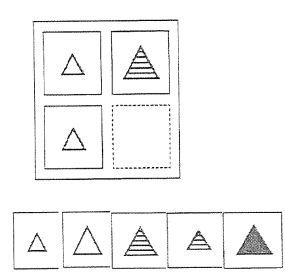
minimal use of language to reduce measurement bias
BUT 27 of the 46 questions were still culturally biased
→ scores were incomparable across cultures
What Is the Reason for the Group Differences? Nature vs Nurture
Nature: the bell curve (Herrnstein & Murray)
IQ is largely inherited
IQ determines success in life
difference between ethnic-racial groups are partly genetic
BUT:
→ ethnicity and race are social constructs - do not correspond to genetic variation
→ ethnicity is confounded with social, educational, and economic factors
Nurture: Flynn effect
IQ scores steadily rise overtime and generations
reasons:
higher education and test familiarity
stimulating environment
nutrition
> NURTURE: FLYNN EFFFECT MORE PRONOUNCED FPR AFRICAN_AMERICAN STUDENTS
change in National Assessment of Educational Progress math scores between 1973 and 1992 by race and age
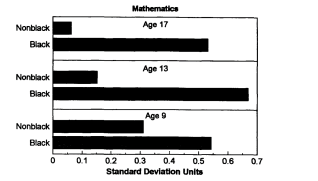
→ supports nurture hypothesis because once African-American’s had a chance to get education their scores improved rapidly
> NURTURE: STEREOTYPE & STEREOTPE THREATS
when widely known stereotypes exist about a group, this creates a threat for members of that group
→ this stereotype threat might interfere with performance in the stereotyped domain
two studies:
stereotype in US that African-Americans are less smart → made race salient by priming then either told participants the test was going to diagnose their abilities or not
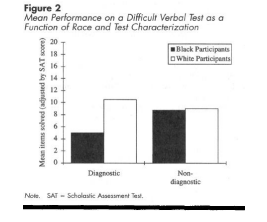
→ non-diagnostic: white and African-Americans scored the same
→ diagnostic: African-Americans scored lower
children of immigrants in EU → question on ethnicity either before and after
→ after group > before group
What Does IQ Mean Cross-Culturally?
Unidimensional?
→ different intelligence criteria all add up to one general intelligence factor (Spearman’s g)
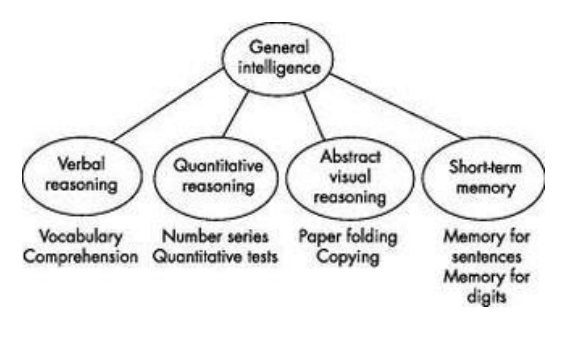
multidimensional?
→ analytical, creative, practical, emotional, social sexual, etc (e.g. Sternberg)
intelligence: “the skills and abilities necessary to effectively accomplish cultural goals”
if you pursuing a professional occupation with a good salary in order to support oneself and family → cognitive and emotional skills and abilities to achieve this
if you want to develop and maintain successful interpersonal relationship → emotional and social skills and abilities to achieve this
M7.2 - SUMMARY
1. Is this racist? → Lynn clearly is
2. Is this good science? → no
→ Did Lynn and colleagues implement well-designed studies? → More broadly: are racial and cultural differences in IQ due to measurement?
3. What is the reason for the group differences? Nature vs. Nurture
4. What does intelligence mean cross-culturally?
M7- KEY TERMS
cognition: all mental processes we use to transform sensory input into knowledge
priming: a method to determine if one stimulus affects the other
carpentered world theory: A theory of perception that suggests that people (at least most Americans) are used to seeing things that are rectangular in shape, and thus unconsciously expect things to have square
corners.
front-horizontal foreshortening theory: A theory of perception that suggests that we interpret vertical lines as horizontal lines extending into the distance. Because we interpret the vertical line in the horizontal–vertical illusion as extending away from us, we see it as longer.
symbolizing three dimensions in two theory: A theory of perception that suggests people in Western cultures focus more on representations on paper than other cultures do, and spend more time learning to interpret pictures → that’s why they are more prone to falling for optical illusions
dialectical thinking: The tendency to accept what seem to be contradictions in thought or beliefs.
positive logical determinism: A tendency to see contradictions as mutually exclusive categories, as either-or, yes-no, one-or-the-other types of categories
naïve dialectivism: A constellation of lay beliefs about the nature of the world (rather than a cognitive style as suggested by dialectical thinking). Naïve dialecticism is characterized by the doctrine of the mean, or the belief that the truth is always somewhere in the middle
social orientation hypothesis: The hypothesis that cultural differences in individualism versus collectivism are associated with differences in social orientation patterns that affect the ways individuals attend to and think about their worlds
serial position effect: The finding that people tend to remember something better if it is either the first or the last item in a list.
gender stratification hypothesis: The idea that gender differences are related to cultural variations in opportunity structures for girls and women.
everyday cognition: An area of study that examines cognitive skills and abilities that are used in everyday functioning that appear to develop without formal education, but from performing daily tasks of living and working
M8.1 - BASIC EMOTIONS
Emotions Definition
What is an emotion?
Emotion: transient, biopsychological reaction to events that have consequences for one’s welfare
→ require an immediate behavioral response
→ includes feelings, physiological reactions, expressive behaviors, and cognitive changes
act as a rapid information system
helps people act with minimal conscious thinking
are a human universal
Categories of emotion?
BASIC EMOTIONS:
universal in all humans, triggered by a biologically-innate system in people’s brains
SELF-CONSCIOUS EMOTIONS:
associated with self-reflective processes
shame
guilt
pride
embarrassment
Model of Emotion Elicitation
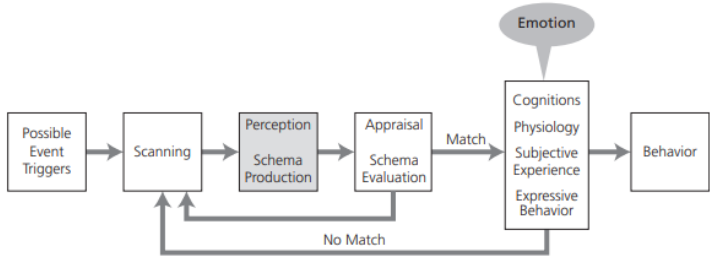
Universal or cultural?
basic emotions are universal, however there are also some culture specific emotions
Biological Bases of Emotion - Basic Emotions
Evolutionary basis - Darwin
tried to find a neurological correlates by stimulating people’s brain
even primates have the basic emotions because they have an evolutionary reason
Ekman
the most convincing evidence for basic emotions’ universality was from studies of Paul Ekman
he also identified the 6 basic emotions:
anger
fear
disgust
surprise
happiness
sadness
Universality of Basic Emotions
Basic emotions - universality studies 1 - Ekman
what emotion is the person in the photo displaying? anger, fear, happiness…
high level of agreement between cultures
BUT all the cultures in the study were literate, industrialized, and relatively modern
→ could it be because every culture in the study has access to tv?
Basic emotions - universality studies 2 - Ekman
to account for the last study being only for industrialized cultures
group in Papua New Guinea who are not exposed to mass media
select a story that best describes a facial expression → consistent with those in industrialized nations
expressions posed by this group were correctly identified by Americans
→ but researchers asked them to display these facial expressions, so is this natural?
Basic emotions - universality studies 3 - Ekman
to account for study 2
do people spontaneously display those expressions when they experience emotions?
American and Japanese participants view
highly stressful stimuli
their facial reactions were videotaped without their awareness
universal expressions
Universality of basic emotions - based on further studies [1-6]+
appraisal
antecedents
physiology
subjective experience
recognition
universality in coherence among emotion response systems
⬇️
> 1. Universality of appraisals that elicit basic emotions
basic emotions seem to be appraised (interpreted) in the same way universally
anger → goal obstruction
fear → threat to physical or psychological well-being
disgust → contamination
surprise → new or novel objects
happiness → goal attainment or achievement
sadness → loss of loved one or object
> 2.📘Universality in emotion antecedents 📘
emotion antecedents: the events / situations that elicit or trigger an emotion
coders sorted the situations into general categories such as good news and bad news, etc → no culture-specific antecedent category was necessary
the most frequent elicitors of happiness across cultures were “relationships with friends,” “temporary meetings with friends,” and “achievement situations.” The most frequent elicitors of anger were “relationships” and “injustice.” The most frequent elicitors of sadness were “relationships” and “death.”
These findings supported the view that emotion antecedents are universal across cultures.
> 3.📘 Universality in physiological reactions 📘
basic emotions has a distinct and discrete physiological signature in ANS
there are also specific patterns in the CNS
> 4.📘Universality in subjective emotional experience 📘
there are differences between the reaction patterns for the different basic emotions BUT these are independent of the country studied
there were many more similarities in the responses across the cultures than there were differences
> 5.📘Universality in emotion recognition 📘
every culture could recognize the six basic emotions in a face
later contempt was also added
> 6.📘Universality in coherence among emotion response systems 📘
not only has the evidence shown that there is universality in the various responses of emotion but also that there is also coherence among them
emotion response system coherence: the various response components (face, voice, physiology) are related to each other in a meaningful way
studies found associations between self-reported expressive behaviors, emotional experiences, and physiological sensations
there were also consistent associations between verbal and nonverbal expressions, as well as between emotion intensity and physiological sensations, all of which suggested coherence in an underlying neurophysiological reality across cultures
8.1 Summary
emotions are a universal psychological phenomena based on the evolution of species
allow people to appraise events in reliable and predictable ways
emotions trigger a host of responses
humans can recognize emotions in others, which has important social meaning
universal processes allow humans to adapt, respond, and cope with problems regardless of the culture
M8.2 - CULTURAL INFLUENCE ON EMOTIONS
OVERVIEW:
• Cultural regulation of basic emotions
• Front-end calibration
• Back-end calibration
• Cultural construction of emotions
• Different emotional experiences
• Emotion concepts and categories
Cultural Regulation of Basic Emotions
Front-end & Back-end calibration
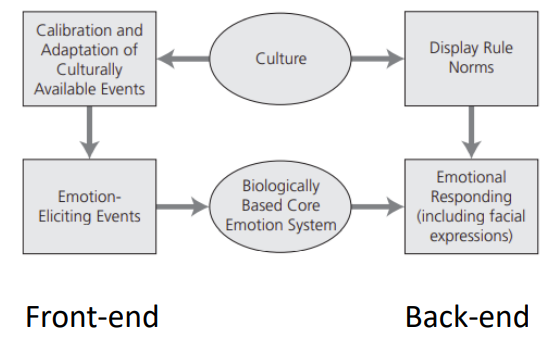
front-end calibration: cultures calibrate and adopt culturally available events
depending on what events are available, it also changes what events elicit emotions
for example, in some cultures people get angry because internet is down and they can’t finish their work. But in other cultures they don’t have internet but they do get angry when their goal is obstructed by something other than the internet
back-end calibration: we express basic emotions differently across cultures because there are different cultural norms on how to display emotions
→ displaying end decoding emotions
Cultural display rules: normative rules modify expression of emotions
deamplification: expressing less than actually felt
amplification: expressing more than actually felt
neutralization: showing nothing
qualification: showing emotion but with another emotion to comment on it (mix it)
masking: masking or concealing feelings
stimulation: showing emotion when not felt
Display rules: motion expression in absence or presence of others (Friesen)
showed American and Japanese participants disturbing stimulus either with a supervisor present or not:
without supervisor: groups showed equal amount of negative expression / emotions
with supervisor: Japanese participants showed negative emotions for a longer time
Display rules in over 30 countries (Matsumoto)
asked whether displaying an emotion was appropriate for certain situations across cultures
most countries’ means expression fell around the midpoint (it shouldn’t be too amplified but shouldn’t be neutralized either)
relatively small variation around this mean
→ a universal norm for some expression regulation
still there is cultural differences…
> Relationship between individualism-collectivism & display rules endorsing expressivity
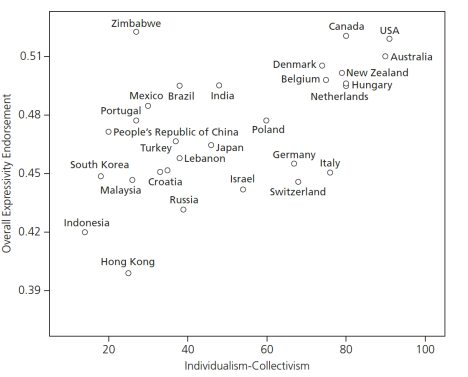
individualism was positively associated with higher expressivity norms (especially for positive emotions)
Cultural decoding rules
culturally dependent rules learned early in life govern how emotional expressions are recognized
“you will be shown different faces displaying emotion. Your task is to identify the emotion, indicate the intensity of expression, and indicate the intensity of what the poser is actually feeling”
Americans: expression > actual experience
Japanese: expression = actual experience
⭐interesting because it was initially thought that Japanese participants would down-regulate their expressions but instead it was Americans that exaggerated their expressions⭐
Cultural Construction of Emotions
Cultural construction of emotional experience
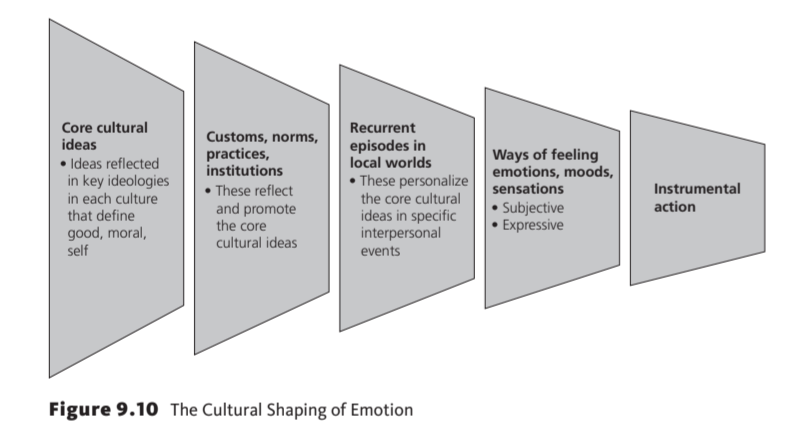
Cultures have different realities and core cultural ideals that lead to different customs, norms, practices, and institutions.
These lead to different individual realities, which are comprised of recurrent episodes in local environments.
These recurrent episodes, in turn, produce habitual emotional tendencies—specific ways of feelings, which give way to behaviors
Categories of emotions
culture-specific words:
“song” (Ifaluk in Micronesia) = justifiable anger
no word for guilt among Raramuri in Mexico
→ hypercognition: identifying variations of emotions and creating words for these variations
→ hypocognition: existence of fewer variations of emotions
⭐some emotions are more important for specific cultures⭐
M8.2 - Summary
M8 - KEY TERMS
affect: Feelings, or subjective experience.
emotions: Transient, neurophysiological reactions to events that have consequences for our welfare, and require an immediate behavioral response. They include feelings, but also physiological reactions, expressive behaviors, behavioral intentions, and cognitive changes.
basic emotions: A small set of emotion categories, or families of emotions, that are considered to be universal to all humans, biologically based and genetically coded, and evolutionarily based. Humans come into the world with programs for these basic emotions; social and cultural learning then influences how they are used in life
emotion antecedents: The events or situations that elicit or trigger an emotion.
emotion response system coherence: the various response components—face, voice, physiology—are related to each other in a meaningful way.
culturally learned decoding: Culturally prescribed rules that govern how emotions should be perceived.
in-group advantage: The hypothesis that individuals can recognize emotions expressed by members of their own culture relatively better than of those from a different culture.
socially engaging emotions: Emotions that occur as a result of themes derived from social interdependence and relationships with others.
socially disengaging emotions: Emotions that occur as a result of themes grounded in independence and autonomy of the self, and its separateness from others.
emotional complexity: The idea that positive and negative emotions can cooccur and be experienced simultaneously.
dialectical thinking: The tendency to accept what seem to be contradictions in thought or beliefs
hypercognition: Relatively greater amounts and forms of knowledge, awareness, and thought about something that go beyond the usual. This term was coined by Levy to refer to cultures that create (hypercognize) many words to differentiate many different emotional states.
hypocognition: Relatively fewer amounts and forms of knowledge, awareness, and thought about something compared to the usual. This term was coined by Levy to refer to cultures that lack (hypocognize) words to differentiate emotional states.
ideal affect: Cultural values associated with how people want to feel.
actual affect: How people actually feel.
M9.1 - PHYSICAL HEALTH
Four Indicators of Health Worldwide
life expectancy
infant mortality
obesity
subjective well-being
Life expectancy
five countries with the highest life expectancies were Japan (84.3), Switzerland (83.5), South Korea (83.3), Spain (83.2), and Singapore (83.2)
five with the lowest were Lesotho (50.8), Central African Republic (53.1), Somalia (56.5), Eswatini (57.7), and Mozambique (58.1). There’s a 33.5-year difference from the country at the top of the list to the country at the bottom
US was ranked 40th at 78.5.
wealth / resources affect the average
differences in across and within countries (ethnic majority > ethnic minority)
Infant mortality
number of infant deaths per 1.000 live births
Countries with the highest infant mortality rates were Lesotho (42.8), Pakistan (41.2), Central African Republic (39.7), South Sudan (38.6), and Somalia (36.9).
Countries with the lowest were San Marino (0.8), Japan (0.8), Singapore (0.9), Iceland (1.0), and Estonia (1.1).
US was ranked 50th at 3.7 → very high for an industrialized country
NL (2.1)
differences attributed to resources (good nutrition, health care, and treatment)
disparities among ethnic groups (black babies are more than twice as likely to die than white babies)
Obesity
BMI > 25 → overweight
BMI > 30 → obese
countries with highest BMI average: Narau, Cook Islands, and Palau
countries with lowest BMI average: Cambodia, India, Timor-Leste
US has the highest rate (adults and children) compared to the economically similar countries
Subjective well-being
perceptions and self-judgements of health and well-being → person’s feelings of happiness and life satisfaction
higher SWB → better health (less susceptible to viruses, CVD, etc)
might be because they lead healthier lifestyles
large country differences
predicted by: wealth, autonomy, connection to others
five happiest countries were Finland (7.81), Denmark (7.65), Switzerland (7.56), Iceland (7.50), and Norway (7.49) → NL was the 6th
five least happy countries were Central African Republic (3.48), Rwanda (3.31), Zimbabwe (3.30), South Sudan (2.82), and Afghanistan (2.57).
US was ranked 18th at 6.94.
Cultural Dimensions & Diseases
looking at the four indicators above, we can see large cross-national differences in health that can both be because of non-cultural and cultural differences
so what are some cultural differences that effect health?
Japanese-American were asked if they continued their traditions at home:
most traditional → lowest incidence of coronary heart disease
least traditional → higher incidence of coronary heart disease
→ cause: acculturation
Triandis:
individualism vs collectivism → heart disease
individualistic countries are more likely to have a heart disease
Matsumoto and Fletcher:
examined associations between health and Hofstede’s four cultural dimensions that are:
individualism vs collectivism
power distance
uncertainty avoidance
masculinity-femininity
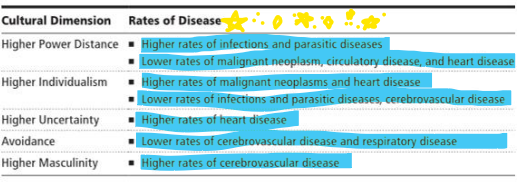
⭐affluence (wealth) was controlled for → there are cultural aspects influencing the prevalence of specific diseases⭐
Cultural Differences in Definition of Health
view of health in western countries:
biomedical model: views disease as resulting from a specific, identifiable cause, a genetic or developmental abnormality, or physical insult → biology is the primary focus, treatment focuses on curing
↳evolved into↴
biopsychological model: views disease as resulting from biological, social, and psychological factors
the concept of balance and imbalance:
holistic views (although western models also agree with balance)
homeostasis: maintaining steady and stable body functioning during environmental changes
differences within countries:
dominant / non dominant ethnocultural groups (immigration)
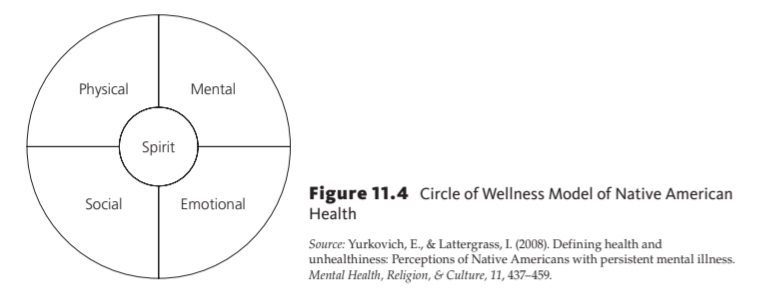
Cultural Discrepancies & Physical Health
when fit between personal and cultural values are low:
more coping required
depression / anxiety
physical health
Psychosocial influences on physical health and disease
Alameda county study:
N = 7k, social contacts, 9 year period → less contacts higher death rate
⭐perceived loneliness is important: how lonely people feel rather than the number of contacts
perceived discrimination:
high blood pressure, higher CVD, negative pregnancy outcomes, earlier biological aging
health disparities:
differences in health outcomes by groups → high SES = better health
Culture, body shape, and eating disorders
body shape ideals and body dissatisfaction → eating disorders
body weight standards and dissatisfaction linked to SES:
heavier figures are preferred in lower SES countries
thinner figures are preferred in higher SES countries
cultural values, beliefs, and opinions about wealth, beauty, and power impact attitudes toward eating, thinness, and obesity
Acculturation and the immigrant paradox
immigrant paradox: immigrants doing better on many health measures despite the hardship
foreign-born (immigrant) Latinos living in US are healthier than Latinos who were born and raised in the US
Researchers attribute this to:
healthy behaviors
social support
immigrant selectivity (those who migrated are more likely to be resilient)
M9.1 - Summary
health disparities exist across countries and cultures, as well as within countries
cultural differences in attitudes, values, beliefs, worldviews on origins of disease and how to treat them, lifestyles and diet, social support, and suicide
understanding the role that culture plays in the development and treatment of disease will take us a long way toward developing ways of preventing disease in the future
M9.2 - MENTAL HEALTH book!
What Is Normal?
individualistic countries tolerate ✨Kanye✨ more than collectivistic cultures
How do we classify what is abnormal?
example:
“A person is in the midst of a group of people but seems totally unaware of their surroundings. They are talking loudly to no one in particular, often using words and sounds the people around them find unintelligible. When questioned later about their behavior, they report that they had been possessed by the spirit of an animal and were talking with someone who had recently died.”
options for interpretation:
statistical approach: thinking that you are possessed by an animal spirit and that you are talking to dead people is not a common experience
limitation: not every rare experience is disordered and nor is every disorder rare
running a four mile is rare but isn’t a disorder
getting drunk is very common but can be a substance abuse disorder
impairment / deviance: doing daily tasks might be difficult if you think you are an animal spirit
limitation: not every disorder causes an impairment
bipolar people can be more efficient during manic episodes
social norms: not everything that is socially deviant is abnormal
what is socially deviant changes over time
so defining abnormality by societal norms is difficult because they are subjective
what some cultures accept others don’t
distress: may depend on how people treat that person
if their abnormal behavior is accepted by their social circle they might not feel distressed
but if their behavior is viewed and treated as strange they may experience stress
social and cultural acceptance is a critical ingredient → homosexuality
Issues with defining abnormality?
🟥absolutist orientation: biological models, invariant symptoms across all cultures
🟨universal perspective: many disorders have identical symptoms (Alzheimer, Parkinson, schizophrenia, autism, etc) → also there is limits due to cultural differences
🟩cultural relativism: disorders can be understood only in the cultural framework → cautions against egocentrism
Classification
assessment issues:
reliability + validity
diagnostic categories
CCD classification systems:
DSM-5 has been revised to include cultural concepts of distress (CCD) and Cultural Formulation Interview (CFI) ↴
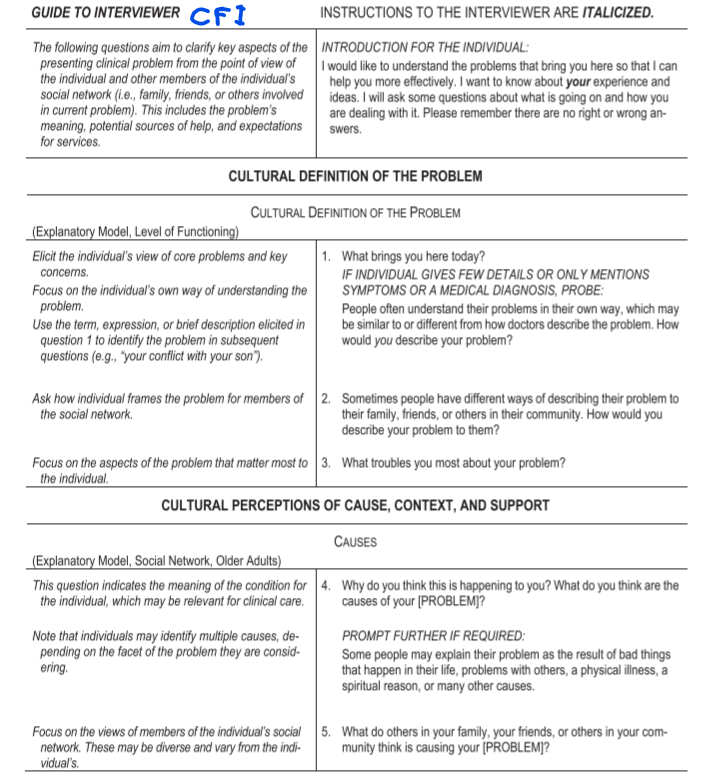
International Classification of Diseases (ICD)
Chinese Classification of Mental Disorders (CCMD)
Cultural concepts of distress (CCD)
CCD is based on three aspects:
cultural syndromes of distress: patterns of symptoms that tend to cluster together for individuals in specific cultural groups, communities, or contexts
cultural idioms of distress: ways that cultural groups and communities communicate and express their distressing thoughts, behaviors, and emotions
cultural explanations of distress: what cultural groups and communities believe is the cause of the distress, symptoms, or illness
Issues in cross-cultural assessment of psychological disorders
bias and equivalence:
measurement bias
items can’t be translated perfectly
child behavior checklist (CBC):
valid and reliable across cultures
HOWEVER different cut off points for diagnosing
doesn’t cover the culture-specific criteria / behaviors
test interpretation:
cultural background of both therapist and client are important for perception and the assessment of psychological disorders
Chinese-American clients were rated as awkward, nervous, depressed and less socially capable by European-American therapists BUT were rated as honest, adaptable, and friendly by Chinese-American therapists (mismatch or match)
assessment differs based on cultural background
measuring personality to assess psychopathology:
Minnesota Multiphasic Personality Inventory (MMPI) has been used across cultures even though it was originally developed with western participants
it is found to be reliable HOWEVER it also pathologizes minority groups more
finding an inventory that works for every culture does not mean that it covers all aspects of personality, it can only represent the common denominator → Arab p. d., South African p. d., and Chinese p. d. assess to that
Results of failure in addressing issues of assessment
overpathologizing: considering behavior as pathological, when behavior is a normal variation for that individual’s culture
underpathologizing: indiscriminately seeing behavior as cultural, when behavior actually reflects abnormal psychological response
Cross-Cultural Research on Psychological disorders
Schizophrenia
unlike popular belief schizophrenia is characterized by delusions and hallucinations, lack of motivation, social withdrawal, impaired memory, dysregulated emotions
⭐biological predisposition following exposure to stressful environment
International Pilot Study of Schizophrenia by WHO
universal symptoms: lack of insight, auditory and verbal hallucinations, and ideas of reference
course of illness was more positive for patients in developing countries than highly industrialized countries→ developing countries recovered faster than industrialized countries (due to social support?)
symptom manifestation varies between countries → patients in US were less likely to demonstrate lack of insight and auditory hallucinations than Nigerian patients (insight and self-awareness more valued in US)
expressed-emotion construct: family and social interactions (e.g. hostility, criticism, over-involvement) influence the course of schizophrenia
over-involvement can cause relapse → but what is considered over-involvement differs across cultures
Cross-cultural context of schizophrenia study(voice hearing experience) in San Mateo (USA), Accra (Ghana), and Chennai (India)
→ overall many similarities of symptoms across different cultures but 3 differences such as:
valence (pleasantness / unpleasantness):
Accra and Chennai → positive / pleasant
USA → negative / unpleasant
relationship:
Accra and Chennai → voices were actual people that they knew
USA → heard voices of unreal people that are usually violent
category (illness or spirit):
Accra → culture accepts that there are spirits
USA → intrusion to private thoughts, illness
⭐similar symptoms but different social responses across cultures which can impact recovery trajectory⭐
Depression
characterized as physical, motivational, emotional, and behavioral changes
women > men
cross-cultural symptoms:
sadness and joylessness
anxiety, tension, and lack of energy
symptoms differ due to variations in stress sources and coping mechanisms
in some cultures it might be more acceptable to show somatic symptoms than psychological symptoms
📘Anxiety disorders📘
there are major cultural differences in what elicits anxiety, how and how much to express it, and what to do about it when experienced
→ Thus, anxiety-related disorders are universally present in human cultures but there are cultural differences in prevalence rates and expression
prevalence rates of anxiety disorders vary depending on both the type of disorder generalized anxiety disorder, panic disorder, and various phobias) and culture
may be related to cultural differences in thresholds for diagnosing their symptoms
→ Thus, standardizing diagnostic criteria across cultures may miss culturally unique features of anxiety, fear, and anxiety disorders
At least partially for these reasons, lifetime prevalence rates of anxiety disorders vary widely across culture
Several cultures around the world also have specific cultural syndromes of distress that have specific labels in those cultures but are rooted in anxiety disorders:
These would include taijin kyofusho in Japan,
koro in Southern China and Southeast Asia, or
ataque de nervios in Latino American cultures
Anxiety disorders may inherently involve cultural beliefs, norms, or patterns describing anxiety-based problems may be impossible without invoking culturally specific meaning
📘ADHD📘
For diagnosis, symptoms must interfere with social and academic functioning to be considered a disorder.
In the DSM, three subtypes have been identified: ADHD with symptoms of inattention, symptoms of hyperactivity and impulsivity, and symptoms of all three.
In contrast, according to ICD criteria, all three types of symptoms must be present to diagnose ADHD.
→Thus, prevalence rates are difficult to compare across cultures when using different diagnostic systems
the core symptoms defining ADHD (inattention, hyperactivity, and impulsivity) were found in samples of schoolage children from 15 countries in Africa, the Arabian Peninsula, Asia, Europe, North America, Oceania, and South America—supporting the notion that ADHD is not merely a Western-based disorder
here were significant differences in prevalence rates between North America compared to Africa and the Middle East (the latter reporting lower prevalence rates) but no differences in rates between North America and Europe, South America, Asia, or Oceania. Based on these results, the authors concluded that there was more variation in prevalence rates due to methodological differences rather than geographical location
⭐But there is evidence for culture-specific attitudes and beliefs about ADHD
→ The authors concluded that symptoms characterizing the disorder may be similar, yet perceptions of its causes and treatment differ between the two countries
Cultural syndromes of distress
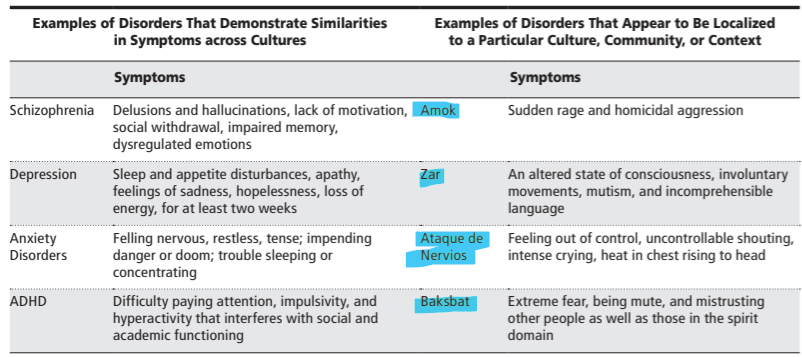
Amok - Asia (Malesia, Thailand, Philippines) - reasons are thought to be stress, sleep depravation, and alcohol consumption
Zar - Ethiopian immigrants to Israel
Ataque de nervios - more common in women, especially in stressful family situations
has similarities with a panic attack but also has additional symptoms so DSM5 is inadequate here
Baksbat “broken courage” - Cambodia - distinct from PTSD
West Africa:
brain fag syndrome: unpleasant head and neck pain, burning or crawling sensations, visual disturbances, and cognitive impairments
koro and koro-like (magical penis loss) syndrome🤏🏻
ode on: sensations of something crawling through the head and other body parts
ogun oru: a person experiences being attacked at night while asleep, is unable to fall back to sleep, and exhibits abnormal behavior like making goat sounds🤨
Susto: caused by a frightening event that may result in “soul loss”. It is characterized by sadness, sleep and eating disturbances, fear of unfamiliar places, impaired social relations with important others, and has been observed in Mexico, Central and South America, and Latino individuals in the United States.
Latah: characterized by an extreme startle response, echolalia (involuntarily and immediate repeating of words another person says), trancelike behavior, or other inappropriate, uncontrollable behavior. It is observed primarily in women in Malaysia.
Peruvian concept known as saladera, which describes anxiety that is associated with a run of bad luck
⭐we need to replace he term culture-bound syndromes: Designating some disorders as “culture-bound” while others are not fostered a perception that one set of disorders was more valid, true, based on knowledge, and universal, while others were more exotic, folk, based on beliefs, and culturally specific → In reality, no psychological disorder can escape cultural encoding, shaping, and presentation; thus, the term culture-bound was inaccurate⭐
- Mental health of ethnic minorities, migrants, and refugees
> AFRICAN AMERICAN
historical context of slavery and exclusion from the social, economic, and educational fronts have influenced their mental health
APA actually apologized in 2021
despite this, they report lower lifetime and 12-momth prevalence rates of major depression disorder
protective factors against mental illness: strong family, community, and religious networks
> REFUGEES
higher PTSD, depression, and anxiety
caused by trauma BUT also because of events (exclusion) after fleeing
dose effect: higher the trauma level, higher the PTSD
- > IMMIGRANTS
acculturation issues → depression, anxiety, psychosomatic problems
but still: immigrant paradox
> LATINO AMERICANS🔎
> ASIAN AMERICANS🔎
> NATIVE AMRICANS🔎
M9.2 - Summary
Universal aspects of symptoms for depression, schizophrenia, anxiety, and ADHD
Culture-specific psychopathologies:
Behavioral and contextual manifestations
Meaning of disorders
Understanding ethnic differences requires considering poverty, discrimination, and (migration) stresses
M9.3 - INTERVENTIONS
Culture & Psychological Interventions
Origins of psychotherapy
western origin
premise: changing our thinking → changing our behavior (vice versa)
cognitive behavioral therapy: one of the most common therapies
Cultural assumptions of psychotherapy
psychotherapy is less effective for non-European descent
different expressions of abnormality
different notions of self
ability of the therapist related to cultural knowledge, understanding, and appreciation
goal of psychotherapy: to help people become more functional within their society → BUT functionality is culturally determined
Psychotherapy in diverse cultures and within cultures
Psychologists include cultural elements (religion → psychological distress)
Culturally modified psychotherapy more effective than non modified psychotherapy
Modifications for minority groups within a cultural setting
Disparities in Receiving Treatment
Not everyone is equally likely to receive treatment.
Between country differences
Within-country differences
What are barriers and obstacles?
language barriers → MOST IMPORTANT
stigma (seeking help can be seen as bad) and trust
beliefs about health and illness (religion)
social validity (is this treatment good or not)
lack of mental health services
How Can We Remove Barriers to Treatment?
How do barriers interact with racial or ethnic backgrounds, immigration status, and socioeconomic status?
Hire bilingual and bicultural staff
Increase outreach (visibility / availability of treatment)
Flexible hours
Reduce stigma
What is the Problem & How Can We Talk About it?
Different ways of thinking and expressing thoughts about illness
Language difficulties
Variations in communication patterns
Cultural variations in hierarchy
Differences in treatment expectations
Involvement of extended family (reputation, privacy)
How can we adjust our services?
Culturally informed services
Matching
Intercultural Competence
Community

Indigenous and traditional healing (Lauren Kirmayer)
community also matters:
indigenous treatments that are not part of the biomedical model
can we combine these with scientific models?
no, but that does not change the importance of these methods for the people
some culture-specific treatments are used worldwide
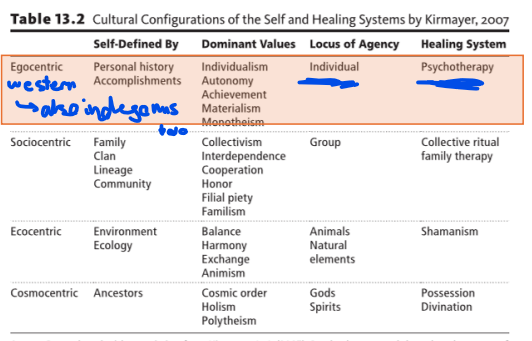
M9.3 - Summary
Therapists’ self-awareness and reflections of their own cultural biases are challenging but must be addressed
Cultural presentations or expressions of distress can be subtle and implicitly conveyed
Clinical dynamics and power within cross cultural therapy dyads are important
M10.1 - LANGUAGE & NONVERBAL COMMUNICATION
General Features of Language
Language, culture, evolution
Evolution of human cultures coincided with the evolution of ability for verbal language
Language is a universal psychological ability in humans
Facilitates creation of shared intentionality
Aids the communication of intentions and beliefs
Existence of human cultures is based on this ability
Each culture creates its own unique language
Language differences help reinforce culture
Structure and features of language
lexicon: words contained in a language
syntax and grammar: system of rules governing word forms and how words should be strung together to form a meaningful utterance
phonology: system of rules governing how words should sound in a language
semantics: meaning of words
pragmatics: system of rules governing how language needs to be used and understood in social contexts
Culture and language acquisition
Humans have an ability to acquire language
Infants produce the same range of phonemes across cultures
Infants’ sound production is shaped and reinforced through interactions with others
Culture provides the rules of phonology, syntax and grammar, semantics, and pragmatics
The reciprocal relation between culture and language
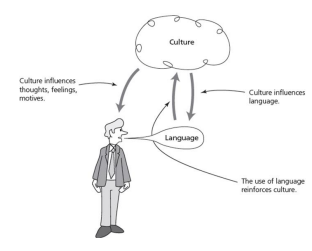
Language Differences across Cultures
Lexicon
Self-other referents → What people call themselves and others (e.g., “you”)
English: you
Dutch: u & je; French vous & tu (formal / informal)
Japanese elaborate system depending on status and intimacy
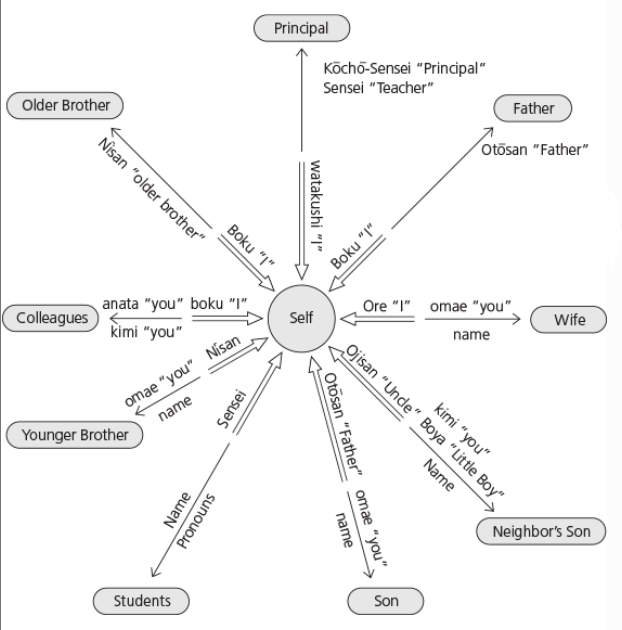
Pragmatics
High-context and low-context communication
High-context: most of the information is already in the person, while very little is in the coded, explicitly transmitted part of the message.
High-context communication: important to read between the lines and consider the rank, age, gender, and class of the communicator
“hear one and understand ten”
“silence is golden”
→ how the message is delivered is more important, what (content) is secondary
Low-context: the mass of the information is vested in the explicit code
Low-context communication: direct message
“get to the point”
“I mean what I say, and I say what I mean”
→ what (content) is said is more important, how is secondary
Does Language Determine Thought? The Sapir-Whorf Hypothesis
Newspeak was the official language of Oceania and had been devised to meet the ideological needs of the totalitarian party called ingsoc
‘To give a single example. The word free still existed in Newspeak, but it could only be used in such statements as ‘This dog is free from lice’ or ‘This field is free from weeds’. It could not be used in its old sense of ‘politically free’ or ‘intellectually free’ since political and intellectual freedom no longer existed even as concepts, and were therefore of necessity nameless.‘
→ because no word exists to describe political or intellectual freedom, people cannot think about freedom either
Sapir-Whorf hypothesis
Speakers of different languages think differently because of the differences in their languages → Linguistic Relativity
Challenges to Sapir-Whorf Hypothesis:
Berlin and Kay (1969) - Suggested that 11 basic color terms form a universal hierarchy
Breugelmans & Poortinga (2006): Rara´muri indigenous group in Mexico use 1 word for guilt and shame but nevertheless differentiate between shame and guilt characteristics
Pinker (1995) - Thoughts can be formed without words and language
Cultural Differences in Nonverbal Communication
Facial expressions and vocal characteristics
Gestures and body postures
Interpersonal distance
Touching behaviors
Gaze and visual attention
Bulk of messages are conveyed nonverbally!
gestures:
speech illustrators: nonverbal behaviors that accompany speech
emblems: culture-specific gestures that convey meaning without words
Gaze, Touch, and Space → contact cultures
Greeting Rituals (see Module 1)
What is conveyed?
What is appropriate?
→ Trump’s awkward handshake
M10.1 - Summary
Language plays a critical role in the transmission, maintenance, and expression of culture
Culture influences language, and language symbolizes what culture deems important – but language doesn’t determine thought
Communication occurs verbally and non-verbally, cultural differences in both domains
M10.2 - INTERCULTURAL COMMUNICATION & BILINGUALISM
Communication Process
encoding: embeds the message in words
channel: can be visual, auditory, touch, smell, or writing
decoding: translate the message into a meaningful message for that person
Types of cultural communication
intracultural communication: occurs among people of the same cultural background
intercultural communication: occurs between people of different cultural backgrounds
Possible Obstacles to Intercultural Communication
Assumption of similarities
Language differences
Nonverbal misinterpretation
Stereotypes
Tendency to evaluate negatively
Stress/Anxiety
Uncertainty/Ambiguity
→ MISMATCH !!!!
Possible mismatch between encoding and decoding
“Kenneth Jones was appointed as the chief of the human resources department in a big Chinese holding “Ghihain”. He found a common language with his subordinates easily and enjoyed working with his Chinese colleagues. One day Mr. Jones received a phone call from his assistant that one of the managers, Dzen Ki, would not be able to come to the office that day. The next morning Dzen Ki showed up in Mr. Jones’s office, offering his apologies. Kenneth asked Dzen Ki about the reason for his absence. With a bow and smile on his face, the Chinese employee replied that his grandmother had died that day. Mr. Jones expressed his condolences to Dzen Ki and supposed that he might not be in a mood to work today. Smiling, Dzen Ki assured him that he is eager to work.”
Jones can interpret this behavior in multiple ways:
A. He did not like his grandmother and was not sorry about her death
B. In Chinese culture death is not considered a sad event
C. Dzen Ki didn’t want to show his real emotions to his superior in order not to upset him.→ Power Distance / Display Rules
D. He inherited a fair amount of money from his grandmother which made him happy.
Low-Context Example
Klaus: Hey, I’m finally moving to my new apartment. I need to start packing.
Bob: Wonderful! When are you moving?
Klaus: This Sunday. I have so many things to move. Could you come and help?
Bob: Sure! My church service ends around noon, so I would be happy to help afterward.
Klaus: Thanks!
High-Context Example
Eujin: Well, I am finally moving to my new apartment. You will be invited to the housewarming party!
Suo: How wonderful! When are you moving?
Eujin: This Sunday. I need to start packing.
Suo: Do you need help? I would be happy to help!
Eujin: Really? I hate to trouble you. . . . You have church on Sunday. . . .
Suo: No worries. It ends at noon, so I can come afterward.
Eujin: Oh . . . are you sure? If you insist. . . .Thanks so much! Suo: My pleasure!
→ but imagine if this convo occurred between Eujin and Bob
Improving Intercultural Communication
Mindfulness: Allows people to be conscious of their own habits, mental scripts, and cultural expectations concerning communication
Components that affect intercultural effectiveness
Motivational → how open we are to different cultures
knowledge → do we know that there re different ways to interpret across cultures
skill factors → empathy
Uncertainty reduction: Efforts to reduce the level of uncertainty and anxiety that one feels when decoding intercultural messages
One must be aware of his/her face and how its maintained across cultures
Face: Concerns with one’s appearance in public or reputation, and the potential embarrassment or shame associated with a threat to that appearance
Emotion regulation
Involves the ability to control one’s negative emotional reactions
Enables one to engage in a more constructive intercultural process
Bilingualism
Biculturals - frame switching
Frame-switching: people maintain multiple self concepts and switch between them depending on context
Such self-concepts are represented by a network of ideas in the mind
Bilinguals - personality and behavior
Study 1. Bilingual participants respond differently on Big Five Inventory in Chinese or English.
→ scored higher on extraversion, openness, and assertiveness when the test was in English
Study 2. Do participants behave differently when using different languages?
Participants: Chinese and English bilinguals (all of Chinese descent) in Hong Kong
Participants were interviewed by one of the Caucasian interviewers and one of the Chinese interviewers in English and Cantonese separately, for about 10 min with each interviewer in each language (4 interviews)
Interviews videotaped and bilingual observers reviewed and rated the videos
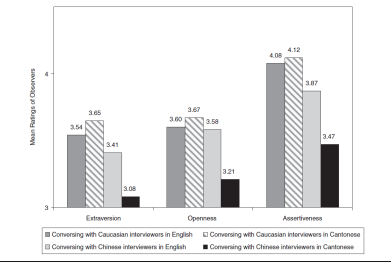
less extraversion, openness, and assertiveness when they were speaking to the Chinese interviewer in Cantonese
Bilingual advantage for cognitive performance
Studies demonstrate that bilinguals selectively attend to stimuli better than monolinguals
It was found that early exposure to a multilingual environment promotes effective communication
Bilingual infants visually track silent video records of adult bilinguals switching languages, but monolingual infants cannot
But overall bilingual advantages in cognitive functioning either do not exist or are restricted to very specific circumstances (like above)
M10.2 - Summary
Understanding differences in nonverbal behavior and how language is used in context (pragmatics) is important for effective intercultural communication
Mindfulness and emotion regulation enhances intercultural sensitivity
Bilingualism: two mental representations of culture, but no overall cognitive advantage
M10 - KEY TERMS
lexicon: The words contained in a language, the vocabulary.
syntax and grammar: The system of rules governing word forms and how words should be strung together to form meaningful utterances.
phonology: The system of rules governing how words should sound (pronunciation, “accent”) in a given language.
semantics: What words mean.
pragmatics: The system of rules governing how language is used and understood in given social contexts.
phonemes: The smallest and most basic units of sound in a language.
morphemes: The smallest and most basic units of meaning in a language.
self–other referents: Terms of address for oneself and others.
high-context cultures: Cultures that promote communication in which many messages are conveyed indirectly in context rather than directly in verbal language.
low-context cultures: Cultures that promote direct communication in which messages are conveyed primarily and directly in verbal languages and the effects of context are minimized.
honorific speech: Speech styles in certain languages that denote status differences among interactants.
Sapir–Whorf hypothesis: The proposition that speakers of different languages think differently, and that they do so because of the differences in their languages. Also referred to as linguistic relativity.
speech illustrators: Nonverbal behaviors, often gestures, that accompany speech and are used to illustrate or highlight speech.
emblems: Nonverbal gestures in specific cultures that carry meaning, like a phrase or sentence.
paralinguistic cues: Aspects of the voice that convey information, such as tone, intonation, pitch, speech rate, use of silence.
proxemics: The use of space in interpersonal relationships.
haptics: The use of touch in interpersonal interactions.
messages: The meanings that encoders intend to convey and decoders interpret.
encoding: The process by which people select, consciously or unconsciously, a particular modality and method by which to create and send a message to someone else.
signals: The specific words and behaviors that are sent during communication that convey messages.
channels: The specific sensory modalities by which signals are sent and messages are retrieved.
decoding: The process by which a person receives signals from an encoder and translates these signals into meaningful messages.
intracultural communication: Communication that occurs among people of the same cultural background.
mindfulness: A Buddhist principle emphasizing close attention to the present moment, being aware of one’s senses, breathing, and thoughts without judgment or evaluation. A strategy to improve intercultural communication that allows people to be conscious of their own habits, mental scripts, and cultural expectations concerning communication. Mindfulness is effective in reducing tension, anxiety, and stress and has been incorporated successfully in cognitive behavioral therapies.
uncertainty reduction: One of the major goals of initial intercultural encounters—to reduce the level of uncertainty and anxiety that one feels when attempting to decode intercultural messages.
face: A key concept in many cultures that refers to claims about one’s social character, integrity, reputation, public appearance, or social image. Other related terms exist, such as gain face, lose face, and show face.
code frame switching: The process by which bilinguals switch between one cultural meaning system and another when switching languages.
foreign language processing difficulties (foreign language effect): Problems associated with learning a foreign language, such as taking more time to respond and experiencing cognitive difficulties while processing information.
M11.1 - SOCIAL INFLUENCE & COOPERATION
The Influence of Culture on Social Behavior
Humans live in groups and group life creates many psychological issues to deal with
Social groups need to have ways of influencing the behavior of others
How these groups handle these situations produce similarities and differences between cultures
Culture & Social Influence
Conformity, compliance, and obedience are important constructs in any social system as ways of reinforcing behaviors
• Conformity: Yielding to real or imagined social pressure
• Compliance: Yielding to social pressure in one’s public behavior, even though one’s private beliefs may not have changed
• Obedience: A form of compliance that occurs when people follow direct commands, usually from someone of authority
Asch experiment on conformity

Simple judgment task
But all other “subjects” (experimental confederates) give the same incorrect response
36.8% of the participants conformed by giving the wrong answer
Conformity highest: in a group of 7 and when unanimous
Milgram experiment on obedience
Cover story: study the effects of punishment on learning
Teacher (T- the research participant) shocks another person (L-learner) (actually a confederate) if wrong or no response. Experimenter (E) in the lab.
“Slight Shock” to “DANGER: Severe Shock,”
65% of the participants administered the most severe levels of shock
Levels of conformity differ across cultures
Asch experiment: Meta-analysis 133 studies in 17 countries
Mean conformity rate 25%
Higher conformity
when larger majority gave incorrect answers
when there were greater proportion of female participants
when majority was an ingroup
higher in collectivistic countries
Milgram paradigm:
9 countries
Obedience from 16% in Australia to 92% in the Netherlands
Might be cultural differences but also other differences in design
Culture & Cooperation
Cooperation: People’s ability to work together toward common goals
Based on unique cognitive abilities (empathy, perspective taking, sharing information)
Cultural differences in cooperation:
Exists because of the sanctioning system within which individuals exist
Punishment promotes cooperation in societies with high rather than low trust
Social-mindedness & performance on environmental protection study
Social-mindedness (SOMI): small acts of interpersonal benevolence such as stepping aside on a sidewalk
Considerable cultural variations
31 samples from industrialized countries and regions
researchers claimed: Greater social-mindedness → better prosocial orientations and performance on environmental protection
Cooperation on concerns of worldwide importance
BUT REALLY THO?!!
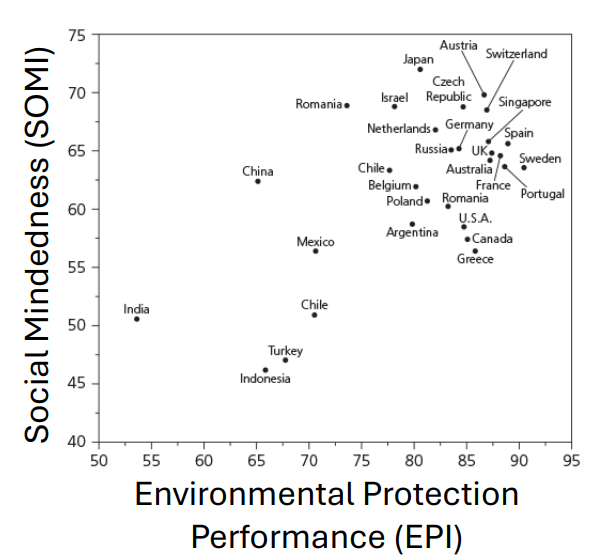
⭐→ indeed, there is a positive correlation between SOMI and EPI, HOWEVER, countries that scored higher are the ones that are richer and richer countries pollute more⭐
But does Environmental Protection Performance (EPI) measure how individuals cooperate on environmental questions?
richer countries score higher on EPI
BUT richer countries emit a LOT MORE green-house gases (GHG) per capita
poorer countries have lower EPI score but they also pollute a lot less
how is this possible?
→ climate change mitigation: EPI measures how much the countries prepare for mitigating for climate change, of course richer countries are able to do this much better
→ only a small part covers GHG
→ environmental health: it looks at having clean water…but this isn’t relevant for GHG (you can still fly and release GHG)
→ ecosystem validity: biodiversity protection, having natural reserves
→ this is not a good way to measure global cooperation to tackle climate change
correlations between social mindfulness and environmental concern:
DOESN’T EXIST IN INDIVIDUAL LEVEL
ecological fallacy: you cannot make inferences about individuals based on cultural level data
M11.1 - Summary
• Cultural differences in conformity and obedience
• Cultural differences in cooperation but less clear relation with real-life outcomes
M11.2 - INTERGROUP RELATIONS
Ingroups & Outgroups, Prejudice & Discrimination
Ingroups and outgroups
Ingroups: Individuals with a history of shared experiences and anticipatory future
→ Produce a sense of intimacy, familiarity, and trust
Outgroups: People who lack ingroup qualities
Infrahumanization of outgroups
Belief that others lack human qualities WHYYYYY
Compare to animals or objects WHYYYYYYYYYYYY?!!?!!

ILLEGAL TF!!!!!!
Cultural differences in ingroup / outgroup relationship
Different cultures ascribe different meanings to the nature and function of self-ingroup and self-outgroup relationships
E.g., work colleagues may be ingroups in one culture but outgroups in another
Individualistic vs. collectivistic cultures
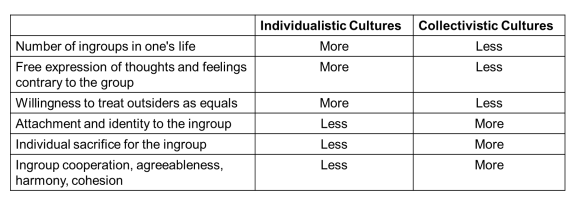
Relational mobility: the degree of freedom and opportunity a culture affords its members to choose and move among interpersonal relationships
more relational mobility → better social skills (e.g. better at self-disclosing → talking about themselves)
Ingroup derogation: how a culture accepts negative attitudes or beliefs about one’s own ingroup
Asian cultures rate their universities, relationships worse than Western cultures (due to dialectical thinking)
Stereotypes and ethnocentrism
Stereotypes:
Generalized images people have about others that can either be positive or negative
Types:
Autostereotypes: Stereotypes about one’s own group (usually positive)
Heterostereotypes: Stereotypes about other groups (usually negative)
Ethnocentrism:
Viewing the world through one’s own cultural filters
Prejudice
Prejudice: Tendency to prejudge others on the basis of their group membership
Includes cognitive (the stereotype) and affective (feelings) components
Explicit prejudice: Verbalized and made public
Implicit prejudice: Prejudicial attitudes, values, or beliefs that are unspoken and outside conscious awareness
Implicit Prejudice
Historical depictions of people of African descent as apes
Historical rationale for racial hierarchy → they look like apes + Dehumanizing Black people
Questions:
Still present in cultural memory in US?
Still impact how Black people are seen and treated?
Research questions [1-3]
1. Is there an implicit association between Black people and apes in contemporary US?
2. Is it related to condoning and justifying violence against Black people?
3. Is it related to death sentencing?
Question 1: is there an implicit association between black people and apes in contemporary US?
Step 1: Priming: Subliminal exposure to Black or White faces
Step 2: Degraded images of apes or non-apes (line drawings) becoming increasingly better quality and more easily recognizable
→ Indicate at what point would they recognize it
Dependent variable: picture frame at which participants could accurately recognize the animal


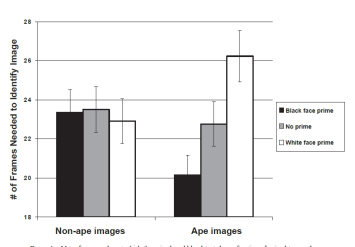
→ when pictures are non-apes: there were no differences
pictures of apes:
→ when they were primed with black faces they could recognize the ape picture faster
→ when they were primed with a white face they recognized the ape pictures way slower
= there is an implicit association!!!!
Method: Prime White students with apes
Method: Measure if priming with apes produces an attentional bias in recognizing Black faces
Dot probe test for measuring attentional bias
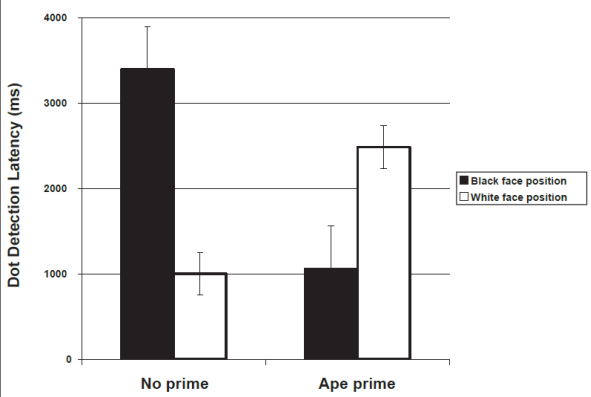
Results:
when not primed with an ape white participants were quicker when the dot was on the white person
there is a an attentional bias: white people pay attention to white faces more than black faces
when primed with an ape participants were quicker when the dot was on the black person
attentional bias shifts the opposite way: there is an implicit association
Question 2: can the activation of the ape-Black association justify violence against black people?
Subliminally prime participants with apes / felines
View a videotape of police violence against Black / White person
Dependent variable: violence justification
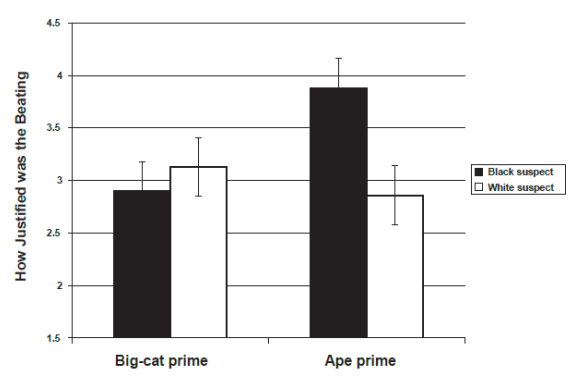
Results:
when primed with an ape → participants found police brutality against black people more justifiable than white people
when primed with a cat → participants level of justification didn’t change between black and white people
Question 3: are black people who are described in more ape-like terms in the media more likely to be sentenced to death?
Compare news coverage of Black and White defendants who were accused of crimes that could be punished by death
Data on 153 death-eligible cases (15 with White defendants, 138 with Black defendants) in the Philadelphia Inquirer
Newspaper articles coded for the presence of words that connoted bestial or subhuman qualities
Next raters asked to think of which animals these words could describe
Results:
Black defendants more likely to be described in ape-like terms than White defendants
The Black defendants who were put to death were more likely to be described in ape-like terms
Discussion
Black-ape association still present
Black-ape association influences:
Judgement of police violence against Black people
Death sentences
Discrimination
there are two kinds of discrimination:
Interpersonal discrimination: Unfair treatment of others based on their group membership → Prejudice is thinking/feeling, discrimination is doing
Institutional discrimination: Occurs on the level of a large group, society, organization, or institution
Known as various “-isms” (sexism, racism, transphobia, homophobia)
Can exist in explicit norms of an organization → a corporate job paying men employees more than women
M11.2 - Summary
Ingroups and outgroups universal, but meaning differs across cultures
Stereotypes, prejudice, discrimination universal
M11.3 - INTERGROUP CONTACT
Does Intergroup Contact Reduce Prejudice?
The contact hypothesis (Allport): interpersonal meeting across group boundaries reduce prejudice
meta-analysis: YES!
→ -.21
Equal contact reduces prejudice more
when members from different groups were friends (equals) prejudice reduced way more than when groups members had an unequal relationship
structured programs that aim for equality can also reduce prejudice (although not as much as equal / friend contact)
Contact in unequal societies
Allport: “Contact in a hierarchical social system … [is] harmful rather than helpful … we see how important it is to abolish segregation before the optimum conditions of contact and acquaintance can occur”
→ slaves and slave owners had contact but it didn’t reduce prejudice
Hypothesis: Contact Reduces Prejudice MORE in MORE EGALITARIAN Cultures (her study)
🧐egalitarian = equal
36 countries, 187.000 participants
in some countries more contact increased prejudice → inequality
in more egalitarian countries, contact reduces prejudice more
BUT group differences:
majority: prejudice reduced (-.23)
minority: bias reduced (-.18)
→ equal contact works more on majority group than the minority group
why? ↴
Why? - majority and minority have different goals and concerns during contact
video: what is an equal and friendly convo for the majority group can still be a racist one for minority groups
Majority:
See contact as more equal
Prefer to focus on commonalities “We are all Americans”
Anxious about seen as racist
Minority:
See contact as less equal
Prefer to acknowledge differences and inequalities
Anxious about being target of prejudice
Methodological concerns
Most studies use self-report: participants report how much contact they have and how prejudiced they are – causality?
Contact interventions also reduce prejudice
Mousa (2020) Christian/Muslim football in Iraq: attitudes remained, behavior less prejudiced in football context
M11.3 - Summary
Contact works
But should be among equals and works better in equal societies
Majority and minority experiences differ
And political limits!
M11 - KEY TERMS
mate poaching: Attracting someone who is already in a romantic relationship with someone else.
conformity: Yielding to real or imagined social pressure.
compliance: Yielding to social pressure in one’s
public behavior, even though one’s private beliefs may not have changed.
obedience: A form of compliance that occurs when people follow direct commands, usually from someone in a position of authority.
cooperation: People’s ability to work together toward common goals.
social capital: The social resources available to a person that can be used to obtain their goals. These include social factors such as interpersonal trust, civic engagement, and time spent with friends.
relational mobility: The degree of freedom and opportunity a culture affords its members to choose and move among interpersonal relationships, allowing individuals to have opportunities to forge new relationships and end others, engage with strangers, and choose friends.
ingroup derogation: Negative attitudes or beliefs about one’s own ingroup.
collective threat: The fear that an ingroup member’s behavior can reinforce negative stereotypes about one’s group.
model minority stereotype: The stereotype of Asian Americans as overachievers
aggression: Any act or behavior that intentionally hurts another person, either physically or psychologically.
cultures of honor: Cultures in which norms place a strong emphasis on status and reputation.
racial microaggressions: “Brief and commonplace daily verbal, behavioral and environmental indignities, whether intentional or unintentional, that communicate hostile, derogatory, or negative racial slights and insults to the target person or group”
acculturation: The process by which people adopt a different cultural system because of continuous contact with a new, distinct, or different culture, and that results in individual change.
intercultural adaptation: How people change their behaviors or ways of thinking in a new cultural environment.
intercultural adjustment: The subjective experiences people have as they adapt their behaviors and thinking
cultural fit: The degree to which a person’s characteristics match those of the new cultural environment in which they will acculturate.
cultural fit hypothesis: The proposition that immigrants and sojourners with characteristics that match their host cultures will adjust better than those with less match.
M12.1 - HOFTEDE’S CULTURAL VALUES MODEL & ITS CRITICISM
Hofstede’s Cultural Values Model
Most cited general framework to classify country level cultural patterns on the country level
Examination of work related values in employees of IBM during the 1970s
Four (classic) dimensions
1. individualism / collectivism
2.power distance
3.masculinity / femininity
4. uncertainty avoidance
Now 6:
Long-term/short-term orientation
Indulgence
Individualism / collectivism
“Individualism pertains to societies in which the ties between individuals are loose: everyone is expected to look after himself or herself and his or her immediate family.”
“Collectivism as its opposite pertains to societies in which people from birth onwards are integrated into strong cohesive in-groups, which throughout people’s lifetime continue to protect them in exchange for unquestioning loyalty”
Power distance
High power distance: hierarchical organizations; they develop rules, mechanisms, and rituals that serve to maintain and strengthen status and power dynamics among members → Iran, Japan, Russia, Saudi Arabia, China
Low power distance: more egalitarian organizations, minimizing rules and customs → US, UK, Canada, Scandinavian countries, Germany
mid: Paraguay, Uruguay, Brazil, Argentina, Spain, Italy, Turkey
Other 4 dimensions
Uncertainty Avoidance: highly refined rules and rituals vs. a more relaxed attitude concerning uncertainty and ambiguity and mandate fewer rules and rituals for their employees.
Masculinity versus Femininity: value success, money, and achievements vs. prioritize nurturing and caring of its members over money and achievement
Long-versus Short-Term Orientation: focus on building relationships and market position vs. short-term, bottom-line profits
Indulgence versus Restraint: relatively freer gratification of basic and natural human desires vs. suppress the gratifications of such desires and regulate through stricter social norms
NL - US - Japan
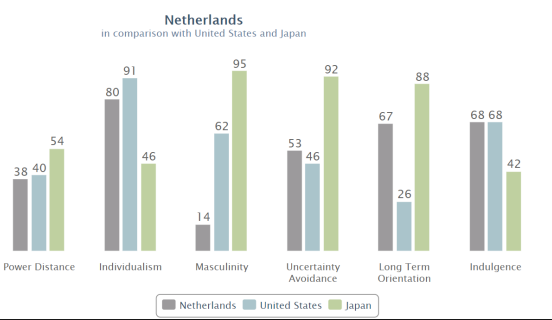
Criticism of Hofstede’s Model
1. Do IBM employees represent national culture? Do the values replicate with other groups and the general public?
2. Does the questionnaire measure the values well?
3. Is the cultural variation meaningful?
4. Ecological fallacy: Some caution with interpretation
Criticism 1: do IBM employees represent national culture? Do the values replicate with other groups?
Whole model doesn’t replicate:
Several FAILED attempts to replicate the whole model with other professional groups e.g. pilots or with representative samples
What replicates: Individualism collectivism and Power distance
What doesn’t replicate: Uncertainty avoidance and masculinity-femininity + 2 dimensions added to revised model
Whynot?
IBM employees more or less representative of the population in different countries
Original studies 50 years ago, cultures change
Criticism 2: does the questionnaire measure the values well?
NO questions aren’t relevant with individualism and collectivism
Criticism 3: is the cultural variation meaningful?
NO
the relationship is very weak, individuals differ more within countries than between countries
the relationship is very weak between uncertainty avoidance and external variables
Criticism 4: Ecological fallacy: some caution with interpretation
Ecological fallacy: infer about individuals based on aggregated country-level data
But: distributions overlap The differences within countries can be larger than the differences between countries
What works then?
Individualism-collectivism measured with other instruments in a reliable and valid way
But differences between countries still small
M12.1 - Summary
Most influential model of cultural differences
Many methodological and conceptual flaws
BUT individualism-collectivism in a meaningful cultural value, just better measured with other instruments and don’t overstate explanatory power
M12.2 - ORGANIZATIONAL CULTURE, LEADERSHIP & DECISION- MAKING
Organizational Culture
information system shared within an organization and transmitted across successive generations
Culture and person-organization fit
Person-culture match:
Workers who had values that were congruent with those of their supervisor were more satisfied and committed.
Organizational identification associated with employee turnover
BUT fit less important when less choice can be made about one’s own career
» Yael Roth, former head of Trust and Safety Twitter
left the company after Elon took over because he didn’t agree with how he made decisions
Culture and attitudes about work and organizations
Different cultures differ in levels of organizational commitment
Normative commitment: Degree to which one’s ties to the organization are bound by duty and obligation
Affective commitment: Level of personal feelings associated with one’s relationship to an organization
⭐both of these are more important in collectivistic cultures⭐
Meaning of work:
connect with self-construal differences (individualistic: work means to an end vs. collectivistic: obligation)
psychological contract: companies and employees responsibility towards each other
Leadership
Culture and leadership behaviors - Hofstede
Leaders in high power distance cultures
Tend to be autocratic or paternalistic in their decision making and interactional style
Close supervision positively evaluated by subordinates.
Leaders in low power distance cultures
Participative and consensual
Close supervision negatively evaluated by subordinates.
Organizational culture: Tesla
There are two schools of thought about how information should flow within companies. By far the most common way is chain of command, which means that you always flow communication through your manager. The problem with this approach is that, while it serves to enhance the power of the manager, it fails to serve the company. …This is incredibly dumb. Any manager who allows this to happen, let alone encourages it, will soon find themselves working at another company. No kidding. …Thanks, Elon
at first he supports low power distance leadership but then contradicts himself
Non-western conceptualization
Paternalistic leadership = hierarchical relationship in which superior provides guidance, nurturance, care and subordinate responds with loyalty
Indonesian example: Bapakism (bapak = father)
Leader acts as a father figure + role model – both participative and authoritative
More in Indonesia, India, Pakistan, Turkey, and China and lowest in Israel and Germany
occurs in high power distance countries but it’s still participative
Boundaries between work/private life differ (here its blurred)⭐
Both similarities and differences across cultures
Culture is bound to differentiate between leadership (and what is effective) in different societies
BUT universal leadership goals: task performance and group maintenance
Common/global technological imperatives and industrial practices harmonize management practices across cultures
Decision-making
Decision-making across cultures - Hofstede
Individualistic: Individual decisions are considered better than group decisions.
Collectivistic: Group decisions are considered better than individual decisions.
Low power distance: managers are seen as making decisions after consulting with subordinates, and informal employee consultation is very possible.
High power distance: managers are seen as making decisions autocratically and paternalistically.
Decision-making is different across cultures
Oligarchy: Organizational structure where rule- or decision-making power is held by few
Elon: individualism and high power distance
even though, US is a low power distance
Ringi: Japanese process of decision making, which involves the circulation of a proposal amongst all stakeholders
Nemawashi: Broad-based consensus-building procedure
Involves extensive consultation and discussion with all relevant stakeholders to ensure buy-in and alignment
collectivistic and low power distance
even though, Japan is a high power distance
⭐ecological fallacy: don’t make inferences about individuals based on cultural levels⭐
M12.2 - Summary
Systemic cultural differences in meaning of work, attitudes about work
Cultural differences in leadership and decision-making
But lot of similarities across cultures as well– leadership goals universal
Beware of the ecological fallacy– e.g. see autocratic decision-making in a low power distance country at Tesla and X/Twitter
M12.3 - WORKING IN DIVERSE ENVIRONMENTS
Work & Studying in Another Country
The four stages of culture shock
Culture Shock: disorientation, anxiety, confusion, doubt, distress, or nervousness that occurs in the process of adapting to new and different cultures
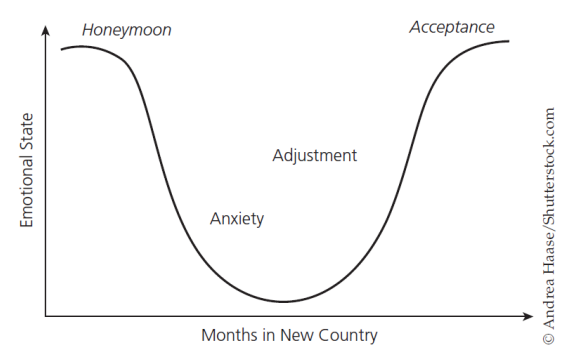
Benefits & Pitfalls of Diverse Organizations
Benefits of diversity at a group-level
higher quality decisions
more creativity
economic growth
more positive intergroup and intercultural relations
Value in group diversity
Optimistic View of Diversity → Information-processing approach:
Diverse groups have more relevant information and perspectives available than homogeneous groups (i.e., have more available resources)
Need to reconcile conflicting viewpoints → thorough processing task-relevant information, reduced risk group think
When groups can combine these resources well (= good process), they can achieve superior performance
Detriments of group diversity
Pessimistic View of Diversity → Social Categorization Perspective:
Diversity creates social divisions which harm teamwork
Similarity-attraction theory
People attracted to similar others
Social identity theories
People categorize themselves and others into groups, with which they identify and which they try to promote (i.e., favoring the ingroup above the outgroup, thereby harming intergroup relations
Intercultural misunderstandings
Diversity as a double-edged sword
More creativity, increased performance, high quality decisions
More conflict, less effective communication (though more satisfaction with work)
…problematic intergroup relations & low group cohesiveness → detrimental to performance
How to reap benefits of diversity?
Reaping the benefits & reducing the costs
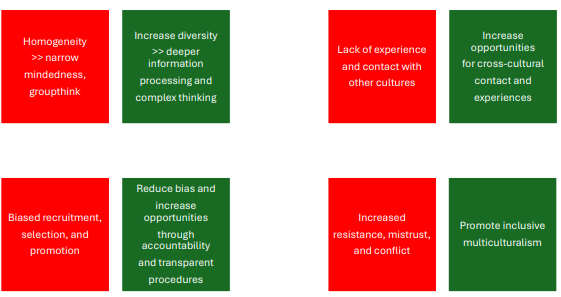
Discrimination remains stable → Ratio 1.3 = non white applicants need to send 30% more applications to be invited as often as white applicants
M12.3 - Summary
Culture shock when working and studying in another country
How to reap the benefits of diverse organizations